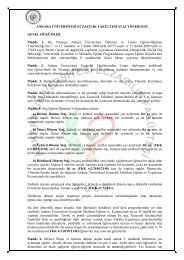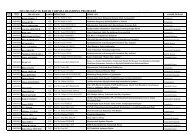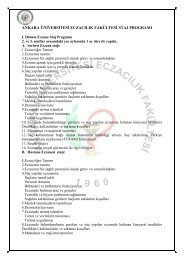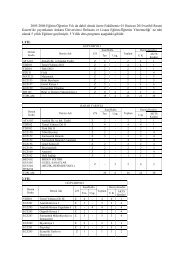Faculty of Pharmacy
Faculty of Pharmacy
Faculty of Pharmacy
You also want an ePaper? Increase the reach of your titles
YUMPU automatically turns print PDFs into web optimized ePapers that Google loves.
Sets, Real numbers, Inequalities, Graphs <strong>of</strong> equations, Functions, Graph <strong>of</strong> a function, Types<br />
<strong>of</strong> Functions, Limits <strong>of</strong> functions, Right and left hand limits, Continuity, Theorems <strong>of</strong><br />
continuity, Derivatives, Derivatives <strong>of</strong> functions, Rules for derivatives. Applications <strong>of</strong><br />
derivatives. Differentials. Indefinite Integrals. Rules for Integrals. Definite integrals.<br />
Applications <strong>of</strong> integrals. Vector algebra. Matrices. Determinants.<br />
(ECZ155) PLANT BIOLOGY (T)<br />
HOUR/WEEK : 2, ECTS: 5<br />
What is Biology, Branches <strong>of</strong> Biology, Beginning <strong>of</strong> Modern Biology, Species, The Concept<br />
<strong>of</strong> Evolutionary Alteration, Principles <strong>of</strong> Evolution, Chemical Basis <strong>of</strong> Life on Earth,<br />
Inorganic Compounds (elements, water, carbon dioxide, oxygen), Organic Compounds<br />
(carbohydrate, lipids, proteins, enzymes, nucleic acids), Cell, Cell Research Methods, General<br />
Characteristics, Microscopically Structure <strong>of</strong> Cell, Cell Membrane, Cell Wall, Protoplasm,<br />
Cytosol, Organelles, Endoplasmic Reticulum, Ribosomes, Golgi Apparatus, Peroxisome,<br />
Mitochondria, Plastids, Vacuoles, Nucleus, Chromosomes, Plant Development, Plant Tissues,<br />
Meristemmatic Tissues, Permanent Tissues, Fundamental Tissues, Protective Tissues,<br />
Conductive Tissues, Supporting Tissues, Secretion Tissues, Plant Organs, Root, Stem, Leaf,<br />
Photosynthesis, Photorespiration, Flower, Fruit, Seed.<br />
(ECZ157) GENERAL CHEMISTRY I (T)<br />
HOUR /WEEK : 3, ECTS: 6<br />
Structure <strong>of</strong> atom, its theories (discovery <strong>of</strong> electrons and nucleus), properties <strong>of</strong> atoms; Periodic<br />
system (general properties): energy level <strong>of</strong> electrons, wave characteristics <strong>of</strong> electrons, spin <strong>of</strong><br />
electrons, quantum number, atomic radius, ionization potential (ionization energies), electron<br />
affinity, Chemical bonding: electronegativity, molecular geometry, hybridization, molecular orbitals<br />
(theory and their shapes), Stoichiometry: atom-gr, mole and equivalent gram concepts, calculation <strong>of</strong><br />
empirical formulae, calculation <strong>of</strong> molecular formulae, chemical reactions oxidation number; Redox:<br />
balancing the chemical equations, chemical equations and related calculations, Gases: gas laws<br />
(Boyle’s law, Charles’s law, Dalton’s law, Avagadro principle, Graham’s law, equations <strong>of</strong> state), the<br />
kinetic theory <strong>of</strong> gases, real gases, the ideal gases, liquification <strong>of</strong> gases, dissolution <strong>of</strong> gases in<br />
liquids, Henry’s law, related problems, Liquids: general properties, equilibrium vapor pressure,<br />
boiling point, heating and cooling curves; phase diagrams, related problems, Solutions: concentration<br />
units, vapor pressure (Raoult’s law), boiling point, freezing point; electrolytes, percent resolution,<br />
interionic forces <strong>of</strong> attraction, solubility, related problems, Solids: general properties, geometry <strong>of</strong><br />
solid, related problems<br />
(ECZ156) GENERAL CHEMISTRY II (T)<br />
HOUR /WEEK : 2, ECTS:4<br />
Chemical kinetics: reaction rates, concentration which is effective on rate, rate equations, other<br />
factors which are effective on rate (temperature, catalyzer, activation energy), order <strong>of</strong> reactions and<br />
determination methods, collision theory, absolute reaction rate theory and calculations, Chemical<br />
equilibrium: equilibrium state, mass action, equilibrium constants, Le Chatelier’s principle, factors<br />
which are effective on the equilibrium, heterogeneous equilibrium and related calculations;<br />
Electrochemistry: electrical conductivity, electrolyses and law’s, galvanic cell, Nernst equation and










